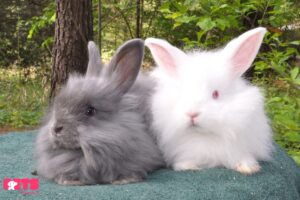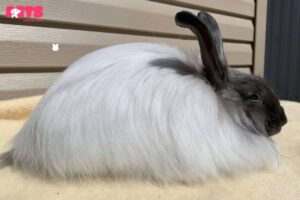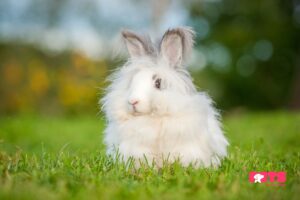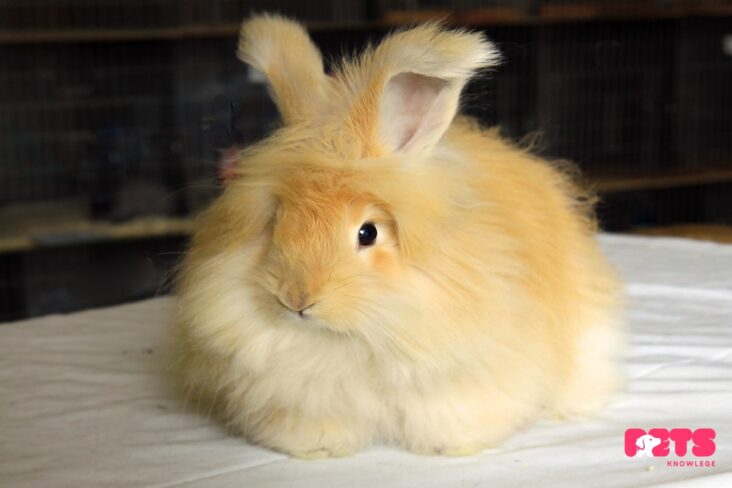One of the first breeds of tamed rabbits is the Angora Rabbit. While it is commonly accepted that this breed started in Turkey in the 1700s, there is evidence that Angora rabbits were present in Roman times as early as 100 B.C.E. In 1723, some angora rabbits were introduced to France, where they became very famous, also being the favorite pet of the monarch Marie Antoinette. The breed was introduced in the United States of America around 1840. During World War II, when wool was needed all over the world, the population grew a lot.
Due to some recessive characteristics, the silky, smooth hair of an angora rabbit grows very fast—about one inch per month. The highly valued angora wool is luxuriant and soft to the touch, much like cashmere; some people are also less allergic to it than to other wools. The largest Angora rabbits can give off up to 4 pounds of wool a year.
Of these many Angora rabbit varieties—there are at least eleven—only four are officially recognized by the American Rabbit Breeders Association (ARBA).
- English Angora
- French Angora
- Satin Angora
- Giant Angora
1. English Angora
The English angora rabbit breed is the smallest of the angora breeds, with an average of 5 to 7.5 pounds when fully grown. Because of its distinctive face and ear “furnishings,” it’s also the most sought-after angora for the display table. It has an 8-year lifespan.
Because this angora contains a higher percentage of wool than guard hair, it benefits from frequent brushing to maintain the coat clear of mats and dirt. This means that while they are gentle with children, they are not suitable to be a child’s rabbit. Coat care is simply too great. They will produce 10 ounces to one pound of fiber per year.
The even-tempered English angora requires accommodation in a wooden hutch. They exist in a variety of colors, like black, blue, and chestnut, and are basically not that hard to care for compared to most bunnies, except for extra time required daily for their grooming.
2. French Angora

These boys are the reverse of the English in terms of the ratio of wool to guard hair, weighing between 7 1/2 and 10 1/2 pounds. In this case the guard hairs make up more of the coat instead of the undercoat, making the French a better choice for novice angora owners and a dream for hand-spinners. This breed lives 7 to 12 years.
Additional or more frequent guard hairs provide room for more saturated colors within the fiber. This, combined with a woolly undercoat, produces what is regarded as the best halo effect on a garment.
French angoras naturally molt so that their coat can be harvested by plucking. This breed is capable of producing up to one pound of wool per year. House the docile French angora in a wooden hutch. This breed is very low-maintenance but it will need to be frequently groomed. They are available in many colors, such as fawn, lilac, and chocolate.
3. Satin Angora

The satin angoras were the product of a cross between a French angora and a satin rabbit. The weight range is 6 1/2 to 10 pounds, with a coat that gives superb sheen due to the special nature of the fiber scales. Satin angora can live 7 to 12 years.
This wool is dense, a hand spinner’s joy to harvest. The spinners at heart label it wonderful to work with because it spins easily. It’s not one of the big wool producers of the bunch, though—only about 10 to 16 ounces of wool a year. Low care; to keep their silky fur intact, brush their coat once a day.
This amiable breed—white, gray, brown and tan—needs to be kept in a proper pen or house; such may be described as a hutch.
4. Giant Angora

One of the highest fiber producers in the group, the giant is the largest of the angora breeds, weighing in at least 9 1/2 to 10 pounds, from one to two pounds of wool per year. While the giant is German in descent, the giant and the German are two separate breeds.
The giant was created by breeding German angoras with other breeds like the Flemish giant to get a bigger rabbit. ARBA recognizes only one color for this breed: white. This breed never sheds its coat naturally and the wool needs to be harvested by hand shearing.
This is a gentle breed that needs to be kept in a hutch. You can expect giant angoras to live 7-11 years. They have less maintenance than other angora breeds because they have less hair on their face and feet.
Caring for an Angora Rabbit
Angora rabbits are intelligent, social animals that generally require less attention than some other rabbits. However, they will do very well when interacted with or played with regularly. They do have special dietary and housing requirements to keep them happy and healthy.
Angoras can live either inside or outside—as long as the hutch is secured from predators outdoors. They tolerate temperatures from 50–75 degrees F but must be kept out of the sun, as they overheat quickly. Insects and other parasites can nest in Angora’s thick fur, and if the fur gets wet outside, Angora rabbits can easily develop skin infections. Generally, inside rabbits are much healthier because they are sheltered from the exposure to infection from other animals or the environment.
Angoras can make wonderful companions if one has time to attend to their grooming. If the household is very busy or one has never had a rabbit before, an Angora is not the best breed to start with.
Angora Rabbit Temperament and Behavior
Angora rabbits are intelligent, friendly, and social. They tend to like spending time with family members and will often play or snuggle with them. They can easily be litter box trained and also come to a call by their name.
However, it is necessary to know the boundaries of your Angora rabbit since they mostly don’t love being picked up and held. A frightened Angora will kick, scratch, or bite in self-defense to get out of holding. Proper holding and observing your rabbit’s body language is crucial to avoid injury to people and the rabbit.
Angora Rabbit Grooming Guide
With their dense and long hair coats, the needs of Angora rabbits regarding grooming are higher compared to other breeds. Actually, with their long silky hair, which easily mats, brushing is necessary several times a week. Its hair grows really fast throughout its whole life; it reaches approximately 1 inch a month.
After about six months of growth the hair may “die” and begin to shed and become matted, so it’s advisable to clip their hair with a shears (or use an electric razor to shave) an Angora rabbit’s fur every three or four months. Great care must be taken in shearing an Angora, as rabbit skin is very thin and rips easily. With that in mind, bringing your Angora rabbit into a rabbit-friendly veterinarian or groomer who is able to safely trim their coat may be the best option.
In addition to regular brushing and shaving, Angora rabbits need their nails trimmed every four to six weeks. Cleaning ears regularly, under the advice of a veterinarian, is also necessary, as well as trimming the fur around their eyes to prevent mats and infection.
Conclusion
One of the oldest breeds of domestic rabbits, Angoras are famous for their luxuriant and fast-growing fur, valued for being soft and hypoallergenic. They have their origin in Turkey and later popularization in Europe and the U.S., after which they were bred into English, French, Satin, and Giant Angora varieties. They do need a lot of grooming and care but will return an owner’s efforts with loving and intelligent companionship. While they are ideal for anyone who has patience to take care of them, Angora rabbits are an excellent addition to add furry joy into the life of a pet owner willing to spend time taking good care of the animal.
FAQS
What special care does the Angora rabbit require?
Other than the regular grooming, an Angora rabbit will need a good diet rich in fiber, regular exercise, nail trimming every four to six weeks, a clean living environment, and regular check-ups at the vet’s to monitor health.
Would an Angora Rabbit make a good idea for a beginner rabbit keeper?
Angora rabbits are not very suitable as first-time rabbit owners, as they take long hours of grooming. They are more suitable to those who have some experience and time to look after them properly.
What type of care does an Angora rabbit specifically need?
Apart from the regular grooming, an Angora rabbit will want a good, high-fiber diet, regular exercise, nail trimming every four to six weeks, and a clean environment in which to live. Regular veterinary check-ups are also important to monitor their health.

